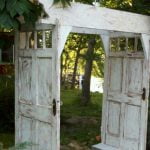Victorian gardens are known for their timeless elegance, intricate designs, and romantic charm. These gardens originated during the reign of Queen Victoria in the 19th century and continue to inspire gardeners today. In this article, we will explore ideas for small Victorian gardens, perfect for adding a touch of classic beauty to compact outdoor spaces.
These small Victorian gardens offer a unique opportunity to create a picturesque oasis right at your doorstep. By incorporating elements like traditional flowers, lush greenery, and ornate decor, you can transform even the tiniest of yards into a whimsical retreat reminiscent of a bygone era. Whether you have a balcony, courtyard, or small backyard, there are plenty of creative ways to infuse your outdoor space with Victorian charm.
From choosing the right plants that thrive in confined areas to maximizing vertical space with trellises and climbing plants, we will provide you with practical tips and inspiration to design your very own small Victorian garden. Additionally, we will explore how to create focal points using features like fountains or statues, as well as incorporating pathways, hardscaping elements, and decorative touches that capture the essence of Victorian-era gardens.
Stay tuned as we delve into the world of small Victorian gardens and discover how to cultivate beauty and tranquility in limited outdoor spaces.
Choosing the Right Plants
Victorian gardens are known for their lush and intricate designs, filled with a variety of flowers and shrubs that exude charm and elegance. When it comes to creating a small Victorian garden, choosing the right plants is essential to ensure the space looks authentic and thrives in its limited area.
Traditional Victorian Flowers
When selecting plants for a small Victorian garden, consider classic options such as roses, peonies, lavender, and dahlias. These flowers were popular during the Victorian era and can bring a touch of nostalgia to your outdoor space. Opt for varieties that are suitable for small spaces and don’t require too much maintenance to keep your garden looking beautiful year-round.
Shrubs for Small Spaces
Incorporating shrubs into your small Victorian garden can add structure and depth to the design. Boxwood, holly, hydrangeas, and Japanese maples are excellent choices for compact areas. These shrubs can be pruned to maintain their size and shape, allowing you to create a manicured look typical of Victorian-style gardens without overwhelming the space.
Seasonal Varieties
To ensure your small Victorian garden remains vibrant throughout the year, consider planting a mix of seasonal flowers and shrubs. Bulbs like tulips and daffodils can bring early spring color, while annuals like petunias and geraniums can fill in gaps during the warmer months. With careful planning and strategic placement, you can create a flourishing garden that captures the essence of a traditional Victorian landscape.
Maximizing Vertical Space
Victorian gardens are known for their lush greenery, vibrant colors, and intricate designs. When working with small spaces, one of the key challenges is maximizing vertical space to create visual interest and make the most of the available area. Fortunately, there are several creative ways to achieve this in a small Victorian garden.
Trellises and Arbors
One effective way to add height and structure to a small Victorian garden is by incorporating trellises and arbors. These features not only provide support for climbing plants but also serve as decorative elements. Consider placing a trellis against a wall or fence to create a stunning backdrop for climbing roses or jasmine. For a more dramatic effect, install an arbor at the entrance of your garden and train vines to grow over it, creating a magical tunnel-like effect.
Climbing Plants
Climbing plants are essential for adding vertical interest to a small Victorian garden. Wisteria, clematis, and honeysuckle are popular choices that not only add height but also fill the air with sweet scents when in bloom.
You can train these plants to grow up trellises, arbors, or even along the walls of your garden for a charming and romantic touch. Additionally, consider mixing different types of climbers to create layers of foliage and flowers that will enhance the overall beauty of your garden.
Vertical Garden Structures
In addition to trellises and arbors, consider incorporating other vertical structures such as obelisks, pyramids, or hanging baskets in your small Victorian garden. These features not only add height but also allow you to utilize the available space more efficiently. Plant fragrant herbs like lavender or trailing flowers like petunias in hanging baskets to bring color and fragrance at eye level.
Vertical structures can also create visual interest by breaking up the monotony of flat surfaces in a small garden. By carefully selecting climbing plants and utilizing vertical structures creatively, you can transform your limited space into a charming Victorian oasis full of beauty and charm.
Creating a Focal Point
When designing a small Victorian garden, creating a focal point is essential to adding interest and character to the space. A central feature such as a fountain, statue, or ornate bench can elevate the overall ambiance of the garden. Here are some ideas for incorporating a stunning focal point in your Victorian-inspired outdoor space:
- Fountain: A classic choice for a Victorian garden, a fountain can bring a sense of elegance and tranquility. Opt for a tiered design with intricate details or go for a more whimsical look with a sculptural fountain featuring cherubs or animals.
- Statue: Choose a timeless statue that complements the style of your garden. Consider classical figures like nymphs, angels, or Greek gods to add a romantic touch. Place the statue strategically to draw the eye and create visual interest.
- Ornate Bench: A beautifully crafted bench can serve both as a functional seating area and an eye-catching focal point. Look for benches with decorative details like scrollwork, floral motifs, or curved arms that reflect the Victorian era.
In addition to these central features, you can also enhance the focal point by surrounding it with lush greenery or colorful blooms. Consider planting fragrant flowers like roses or lavender near the fountain or placing potted plants around the base of the statue to create a cohesive and inviting display.
Ultimately, choosing the right central feature for your small Victorian garden should reflect your personal style and preferences while staying true to the historical aesthetic. Whether you opt for a grand fountain, an elegant statue, or a charming bench, make sure it becomes the centerpiece that ties together all elements of your enchanting outdoor retreat.
Pathways and Hardscaping
Victorian gardens are known for their charm and beauty, even in small spaces. When designing a small Victorian garden, incorporating elements like winding pathways, bricks, and gravel can enhance the aesthetic appeal while maximizing the limited area available.
One idea for small Victorian gardens is to create meandering pathways that lead visitors through the garden, allowing them to appreciate the beauty of each plant and flower along the way. Using materials such as bricks or gravel for these pathways adds a traditional touch that complements the Victorian style.
In addition to pathways, hardscaping features like decorative borders or edging can help define different areas within a small Victorian garden. For example, using low brick walls or hedgerows to separate a flowerbed from a seating area can add structure and visual interest to the space.
Incorporating ornate iron gates at entry points or along pathways can also evoke the elegance of Victorian-era gardens. These details contribute to the overall charm and character of a small Victorian garden, making it a delightful place to relax and enjoy nature.
Moreover, integrating different textures, colors, and patterns into the design of pathways and hardscaping elements can elevate the visual appeal of a small Victorian garden. Mixing materials like bricks with intricate mosaic patterns or combining gravel with stepping stones can create unique focal points that draw attention and add personality to the outdoor space.
By paying attention to these details and carefully selecting plants that thrive in small garden settings, it is possible to create a beautiful Victorian-inspired oasis right at home.
| Victorian Gardens Element | Design Tips |
|---|---|
| Pathways | Create meandering paths with bricks or gravel for a traditional look |
| Hardscaping Features | Use decorative borders or edging to define different areas within the garden |
| Textures and Patterns | Mix materials creatively to add visual interest and focal points |
Incorporating Victorian Elements
Victorian gardens are known for their whimsical and elegant elements that add charm and character to outdoor spaces. When it comes to designing a small Victorian garden, the details matter just as much as the overall layout. One key aspect of creating an authentic Victorian feel is incorporating decorative elements such as wrought iron decor, antique garden furniture, and decorative birdhouses.
Wrought iron decor can instantly transport your small garden to the Victorian era. Consider adding wrought iron gates, fences, or trellises to give your space a sense of elegance and sophistication. These pieces not only provide a visual appeal but also serve a practical purpose by defining different areas within your garden.
In addition to wrought iron decor, antique garden furniture is another essential element for achieving an authentic Victorian look. Opt for ornate metal tables and chairs with intricate designs or vintage wooden benches with intricate carvings. These pieces not only offer functional seating options but also serve as eye-catching focal points in your small Victorian garden.
To further enhance the charm of your Victorian-inspired outdoor space, consider adding decorative birdhouses throughout your garden. These quaint structures not only invite birds to visit but also add a touch of whimsy and nostalgia to the ambiance. Choose birdhouses with intricate architectural details or paint them in pastel shades to complement the traditional Victorian color palette.
| Element | Use |
|---|---|
| Wrought Iron Decor | Provides elegance and sophistication while defining areas |
| Antique Garden Furniture | Offers functional seating and serves as eye-catching focal points |
| Decorative Birdhouses | Invites birds while adding whimsy and nostalgia to the ambiance |
Maintenance and Care
Maintaining a small Victorian garden is essential to keeping its charm intact year-round. To ensure your garden stays healthy and thriving, regular care and attention are needed. Here are some tips and advice on how to maintain your small Victorian garden:
- Regular watering: Victorian plants often require consistent moisture, so be sure to water regularly, especially during dry spells. Consider investing in a soaker hose or drip irrigation system to ensure even watering.
- Pruning and deadheading: Keep your Victorian garden looking neat and tidy by regularly pruning back any overgrown branches or deadheading spent flowers. This will not only improve the overall appearance of your garden but also promote new growth.
- Weeding: Stay on top of weeds in your small Victorian garden by regularly pulling them out by hand or using a hoe. Mulching can also help suppress weed growth while adding a decorative element to your garden.
In addition to regular maintenance tasks, it’s important to monitor the health of your plants and address any issues promptly. Look out for signs of pests or diseases, such as yellowing leaves, holes in foliage, or unusual spots. Consider using organic pest control methods or consulting with a local nursery for advice on treatment options.
Lastly, don’t forget about seasonal care for your small Victorian garden. In the fall, consider planting bulbs for spring blooms and cleaning up any debris that could harbor pests over winter. In the spring, fertilize plants as needed and continue regular watering as temperatures rise. By staying proactive with maintenance and care, you can keep your small Victorian garden looking beautiful throughout the year.
Inspiration From Historical Gardens
Victorian gardens have a unique charm that can bring life and elegance to even the smallest of outdoor spaces. By incorporating traditional elements and thoughtful design choices, you can create a beautiful Victorian-inspired garden oasis right in your own backyard. From choosing the right plants to maximizing vertical space, there are plenty of ideas for small Victorian gardens that can help bring your vision to life.
When selecting plants for your small Victorian garden, consider traditional flowers and shrubs that thrive in compact spaces. Classics like roses, lavender, delphiniums, and peonies not only evoke the romantic feel of a Victorian era garden but also add color and fragrance to your outdoor retreat. These plants can be strategically placed throughout your garden to create depth and visual interest, even in limited space.
Incorporating elements like trellises, arbors, and climbing plants can help maximize vertical space in your small Victorian garden. By adding height with these structures and carefully chosen climbing vines or roses, you can create a sense of intimacy and enclosure within your outdoor haven. Additionally, creating a focal point such as a fountain, statue, or ornate bench can draw the eye and provide a sense of purpose to your garden design.
Remember to also pay attention to pathways and hardscaping choices, using winding paths lined with brick or gravel to enhance the old-world charm of your Victorian-inspired oasis. With the right mix of plantings, structures, and whimsical touches like wrought iron decor or antique furniture pieces, you can transform even the tiniest outdoor space into a lush paradise reminiscent of historical Victorian gardens.
Frequently Asked Questions
What Are the Ideas for a Victorian Garden?
Ideas for a Victorian garden encompass a lush, romantic style characterized by intricate designs, colorful flower beds, and ornate features like wrought-iron furniture and wooden arbors. Using flowers such as roses, peonies, and lavender can help achieve the desired vintage look.
How Do You Make a Small Garden Beautiful?
To make a small garden beautiful, consider maximizing space with vertical gardening techniques like trellises or hanging planters. Utilizing a variety of plants with different heights and textures can add depth and interest to the limited space. Incorporating decorative elements like whimsical planters or garden ornaments can also enhance the overall aesthetic.
How to Build a Victorian Garden?
Building a Victorian garden involves careful planning to create a harmonious balance of color and structure. Begin by designing formal pathways bordered by neatly trimmed hedges or boxwood shrubs. Adding elaborate fountains, gazebos, and intricate paving patterns can evoke the opulent feel typical of Victorian gardens. Remember to maintain the garden meticulously to preserve its elegant appearance over time.

Welcome to my gardening blog! I am passionate about plants and enjoy sharing my knowledge and experiences with others. In this blog, I will write about everything related to gardening, from tips on how to get started to updates on my own garden projects.





